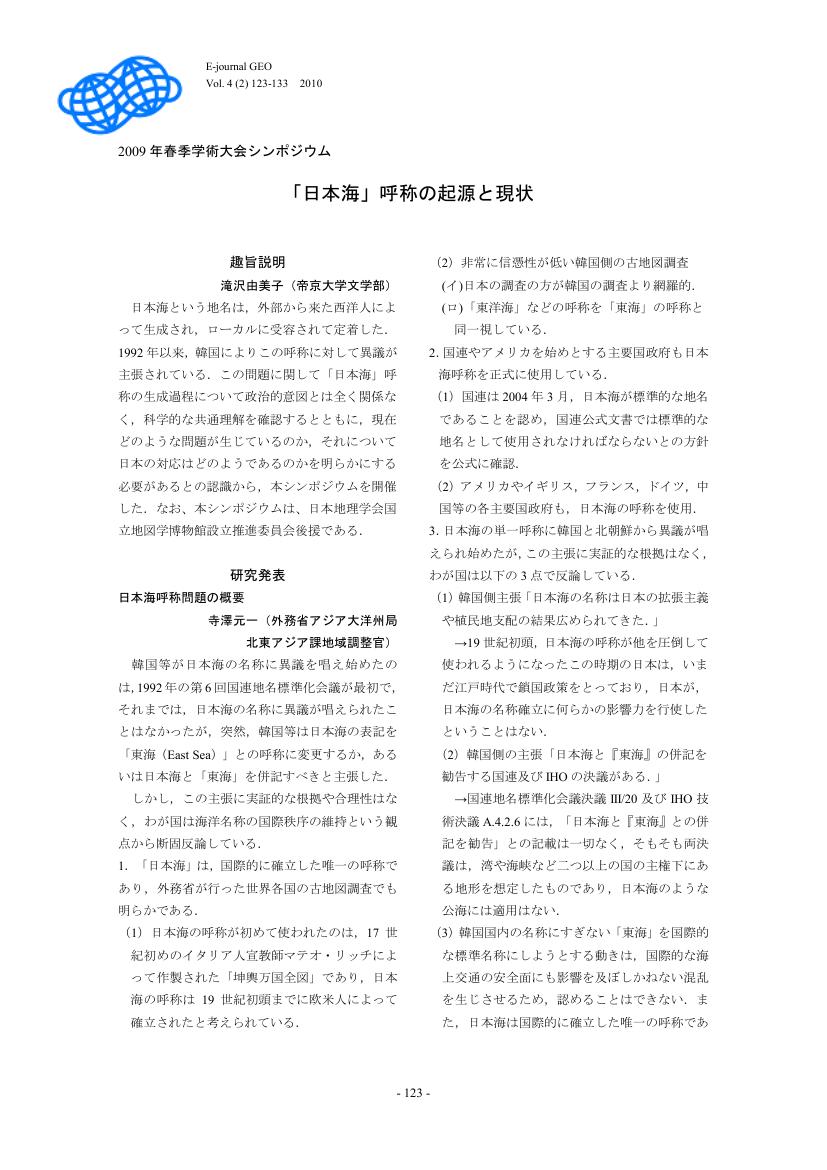9 0 0 0 OA 「日本海」呼称の起源と現状
- 著者
- 滝沢 由美子 寺澤 元一 伊藤 友孝 磯部 民夫 谷治 正孝 渡辺 浩平 KOMEDCHIKOV Nikolay N. 青山 宏夫 中村 和郎 田邉 裕
- 出版者
- 公益社団法人 日本地理学会
- 雑誌
- E-journal GEO (ISSN:18808107)
- 巻号頁・発行日
- vol.4, no.2, pp.123-133, 2010 (Released:2010-04-06)
- 被引用文献数
- 1
2 0 0 0 OA シーボルトが手に入れた日本図と日本の地理情報
- 著者
- 青山 宏夫
- 出版者
- 日本地図学会
- 雑誌
- 地図 (ISSN:00094897)
- 巻号頁・発行日
- vol.56, no.1, pp.24-39, 2018-03-31 (Released:2019-06-17)
- 参考文献数
- 31
- 被引用文献数
- 1
Ph. F. von Siebold came to Japan to serve as physician at the Dutch Trading Post on Deshima in Nagasaki and, upon his return to Europe in 1828, he attempted to take with him a map of Japan, a prohibited item, that he had received from Kageyasu Takahashi, who was in government service as Tenmonkata. When the map was discovered by the government, the persons involved were apprehended and the map was confiscated. This was the so-called “Siebold Incident.” Siebold, however, had covertly made a copy of the map, which he took with him out of the country. Siebold produced a map based on the map he had brought back and published the map, which depicted the shape of the Japanese archipelago more accurately than those existing in Europe at the time, in Leiden, Holland in 1840.The paper identified this map of Japan which Siebold obtained from Kageyasu Takahashi and used as the original source of the Siebold’s map of Japan. In research to date, the map has been conjectured to be the Kana-gaki Inō Tokubetsu Shōzu( Special Small Inō Map with Kana Notations), which is in the collection of the National Diet Library, though there has been no direct evidence that would actually prove this. For verification, a survey was conducted of map materials in the possession of the von Brandenstein-Zeppelin family, descendants of Siebold who currently reside in Germany.This group of map materials has not been well known in map research thus far. After first providing an introduction, it is pointed out that, as a characteristic, it is comprised primarily of handtraced maps, drafts and such. Due to this characteristic, it was possible to determine from this group of map materials the manner in which Siebold actually carried out tasks involving maps. As a result of the survey, five maps of Japan were found that would appear to have a relationship to the Kanagaki Inō Tokubetsu Shōzu. In particular, through a detailed examination of scale and notation content on two of the maps, items 22 and 26, unique characteristics were identified that are apparent in the Kana-gaki Inō Tokubetsu Shōzu, providing definite proof that they were copied. At the same time, by clarifying, based on new materials relating to the Siebold Incident, the content of testimony given by Kageyasu Takahashi, who was subjected to interrogation for the crime of providing Siebold with the map of Japan, a prohibition item, it was confirmed that the map of Japan at issue is indeed the Kana-gaki Inō Tokubetsu Shōzu.Furthermore, examining the place names and longitude/latitude notations on map item 22, it was verified that the major source is Shoshū Keii (Siebold-collection of Leiden University Library), which is an abridged version of Chisei Teiyō(Outline of the Geography of Japan) edited by Kageyasu Takahashi, in addition to the source provided by A. J. von Krusenstern. Based on the facts mentioned above that the Kana-gaki Inō Tokubetsu Shōzu is a map edited by Kageyasu Takahashi and that the major source of information concerning the place names and longitude/latitude notations is Kageyasu Takahashi, it was clarified that he was not merely a provider of a map of Japan but contributed considerably to Siebold’s map of Japan as the provider of his own unique geographical product.
1 0 0 0 OA マテオ=リッチ世界図と近世日本
- 著者
- 青山 宏夫
- 出版者
- 人文地理学会
- 雑誌
- 人文地理学会大会 研究発表要旨 2013年人文地理学会大会
- 巻号頁・発行日
- pp.12-15, 2013 (Released:2014-02-24)
近世日本における世界図は、仏教系世界図、南蛮系世界図、マテオ=リッチ系世界図、蘭学系世界図などに系統分類され、とくに南蛮系世界図をのぞく三者は近世を通じて併存していたといわれている。また、これらに加えて、17世紀半ばから18世紀前半に流布した万国総図やその影響下にある世界図を、別の系統に分類する見解もある。本報告では、この点を再確認したうえで、これらの異なる系統の世界図はいかにして併存しえたかという課題設定のもと、とりわけ近世を通じて影響力を維持したマテオ=リッチ作製の世界図に基づく世界図を中心に、当時の思潮にも注意しつつ、近世日本における世界図史を検討する。また、この過程で、坤與万国全図の諸版とその写本・増補、その影響下にある刊行図などを検討することにより、坤與万国全図をはじめとするマテオ=リッチ世界図が、その東西両半球図を含めて、近世日本にいかにして受容されたかについても考察したい。
1 0 0 0 IR メタモルフォーゼの列島史
- 著者
- 青山 宏夫
- 出版者
- 国立歴史民俗博物館
- 雑誌
- 国立歴史民俗博物館研究報告 (ISSN:02867400)
- 巻号頁・発行日
- vol.163, pp.359-362, 2011-03
1 0 0 0 マテオ=リッチ世界図と近世日本
- 著者
- 青山 宏夫
- 出版者
- 人文地理学会
- 雑誌
- 人文地理学会大会 研究発表要旨
- 巻号頁・発行日
- vol.2013, pp.12-15, 2013
近世日本における世界図は、仏教系世界図、南蛮系世界図、マテオ=リッチ系世界図、蘭学系世界図などに系統分類され、とくに南蛮系世界図をのぞく三者は近世を通じて併存していたといわれている。また、これらに加えて、17世紀半ばから18世紀前半に流布した万国総図やその影響下にある世界図を、別の系統に分類する見解もある。本報告では、この点を再確認したうえで、これらの異なる系統の世界図はいかにして併存しえたかという課題設定のもと、とりわけ近世を通じて影響力を維持したマテオ=リッチ作製の世界図に基づく世界図を中心に、当時の思潮にも注意しつつ、近世日本における世界図史を検討する。また、この過程で、坤與万国全図の諸版とその写本・増補、その影響下にある刊行図などを検討することにより、坤與万国全図をはじめとするマテオ=リッチ世界図が、その東西両半球図を含めて、近世日本にいかにして受容されたかについても考察したい。
1 0 0 0 OA 「シーボルトが紹介しようとした日本」の復元的研究
本研究は、ヨーロッパ各地の博物館、大学、図書館ならびに末裔宅に所蔵されるシーボルト関係文書並びにシーボルトが日本滞在中に収集した日本産業・生活文化資料を横断的に調査・研究し、シーボルトがヨーロッパでどのような構想をもとに日本を紹介しようと試みたのか、その一端を復元的に研究しようする試みであった。今回の調査でミュンヘン国立民族学博物館にシーボルトが死の直前まで行っていた日本展示の構成を具体的に示す目録が発見され、これをもとに展示品を抽出した。その結果、シーボルトの日本紹介は従来の美術・工芸を中心とした日本紹介と異なり、日本の産業とその産業に従事する日本人の生活文化の紹介に主眼が置かれていることが分かった。このことから、シーボルトが意図した日本紹介は、独自の発想にる異民族およびその文化の理解の方法に基づいて行われていることが分かり、今後シーボルトの民族学的な思想を解明する手がかりを得ることができた。また、本研究を通じて、ヨーロッパ各地の関係諸機関に分散して所蔵されているシーボルト関係資料を横断的に調査・研究する方法が必要不可欠であることが認識された。このためには、画像付きデジタル・データベースの共有化が最適であるため、最初の試みとして、ミュンヘン国立民族学博物館所蔵のシーボルト・コレクションおよびシーボルトの末裔フォン・ブランデンシュタイン家所蔵のシーボルト関係文書の画像付きデジタル・データベースの構築を開始した。
1 0 0 0 新聞折り込み広告に掲載された地図の情報
- 著者
- 青山宏夫
- 出版者
- 大明堂
- 雑誌
- 情報化社会の地域構造
- 巻号頁・発行日
- pp.171-182, 1989
- 被引用文献数
- 3
